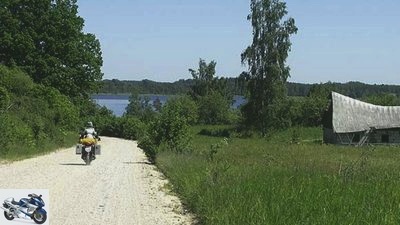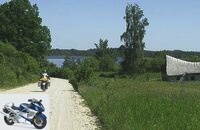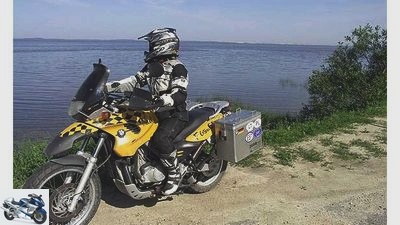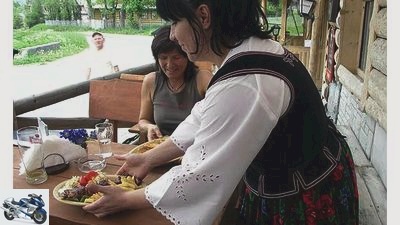Table of contents

Lorenz
to travel
Poland and the Baltic States
Poland and the Baltic States
Stars in the east
Estonia, Latvia and Lithuania: Completely different in language, temperament and culture, the three small countries have replaced the gray of the Soviet era with the colors of the new beginning. The journey there leads through Poland, whose charms are in tune with the beauties of the Baltic States.
Claudia Lorenz
02/14/2008
To make a big loop through Eastern Europe, to explore Poland and the three new stars in Europe’s travel heaven, the Baltic states of Estonia, Latvia and Lithuania, on a motorcycle – that was our dream. Since joining the EU in 2004, the three small countries have made it easier than ever to invite you to a voyage of discovery. For us, Poland is not just a transit country, but a full member of our “loop dream”: On a south-east course inland to Tallinn, then on the Baltic coast back to Germany. That will be more than 6000 kilometers, so let’s go.
Behind the Polish border, the lignite dump near Bogàtynia is tearing its throat open. One of the largest in Europe and also the supplier of the nearby power plant. Poland is increasingly relying on lignite and hard coal as energy sources in order to secure a certain independence from Russia, as a friendly Silesian explains in perfect German.
Buy complete article

Poland and the Baltic States
Stars in the east
7 pages) as PDF
€ 2.00
Buy now
On a varied lane near the Czech border through the south of Poland, the journey is fast. The Schneekoppe rises above us at a clear 1602 meters. Everything looks tidy, the villages may be in need of renovation, but the people are open-minded and friendly.
Behind Wadowice the road winds its way uphill towards Zakopane. From afar the last remains of snow shine on the granite peaks of the High Tatras. The winter sports area attracts thousands of hikers in summer up to the mighty summit cross of the 1894 meter high Gierwont. Anyone who observes the inhabitants of the mountainous Tatra foothills in their traditional costumes, who registers the architectural style of their houses, feels reminded of the Black Forest. Even the road arouses associations: Steep and winding, it meanders to almost 1000 meters and provides a final view of the mountain range.
The forest Carpathians begin behind it. Lonely streets lead down into their picture-book landscape. Only the small campsite near the street offers little picturesque. Two sinks with dripping taps in the open air, next to them a shower tray with a garden hose and ice-cold dark brown water from all pores. well then!

Lorenz
The wooden Orthodox Church of Kománcza.
During the next stage we would like to see this cooling down again, because the thermometer relentlessly climbs above the 30-degree mark. After almost 400 kilometers in the hardly cooling airstream, we roll tiredly into Kaziemierz Dolny on the Vistula. A picturesque town of 4,000 souls, dramatically towered over by a castle ruin and the former watchtower, while flowers, fruit, vegetables, sausages, cheese and bread are traded on the historic Rynek market square below.
We get to the pilgrimage site of Grabarka on gravel roads. For the Orthodox Church, the holy mountain with its 20,000 crosses is one of the most important pilgrimage sites in Poland. We do without the holy spring water, but have to endure 14 hours of continuous rain in the Wigierski National Park. We reached the Lithuanian border at Ogrodniki flying blind. Crossing borders has been easy since the Baltic countries and Poland joined the Schengen Agreement.
Soon the Lithuanian capital Vilnius welcomes us with artfully restored, baroque rows of houses, well-tended green spaces and surprisingly Mediterranean flair. The people seem open, modern and self-confident. Stylish cafes beckon in the backyards and on the Cathedral Square under the free-standing, almost 60-meter-high bell tower. Like Prague, Vilnius is a city of towers.
We continue on the highway 102 towards Zarasai. The first 50 kilometers are well developed, but loose gravel begins from Pabrade. Residential areas, deep ruts, dust and mud passages now alternate – real enduro terrain. We do everything we can to avoid throwing our BMWs in the dirt. Driving only becomes more relaxed in Aukstaitija National Park. Countless lakes, rolling hills, babbling brooks and dense forests make you forget your exertion.
Immediately after the border with Latvia we drive on the A 13 towards Daugavpils. Heavy rain reduces visibility to zero and turns the asphalt into soft soap. Once in town, we take refuge under the roof of a gas station. A resident German tells us that there are still many Russians living in the Latvian border area with Belarus and Russia, but that their culture is now very unpopular in the Baltic States. Vodka is increasingly being replaced by beer, and the former compulsory language Russian is spoken unwillingly. In the absence of industry and tourist attractions, this region would get sidelined.
When the rain subsided, we went to Aglona, but couldn’t find a place to camp. An elderly lady spontaneously invites us to pitch our tent in her garden. It’s beautiful because your property borders directly on Lake Cirišs. At dinner she talks in broken German about her father who taught her the language. After the war he paid bitterly for his fighting on the German side at the age of fifteen in a camp in Siberia. The old lady talks herself in a rage, the hatred of the former occupiers is still deep.
The next morning the sun finally asserts itself against the rain clouds. It is difficult for us to leave the idyllic and friendly accommodation. We are warmly bid farewell. Following the Latvian tradition, according to which travelers are given a little something on the way, our hostess gives us a huge loaf of bread, half a kilo of sausage and two candles. We say goodbye with emotion.
Again on the A 13 we follow this to Rezekne, where we change to the P 35. We enjoy the drive through lonely pine and birch forests, past meadows and fields. On the roofs of the farms, young storks stretch their necks out of their nests. Another gravel road begins at the junction to Gulbene. Standing we fly over the washouts and pull a mighty plume of dust through the forest.

Lorenz
The Polish seaside resort of Sopot breathes the vastness of the Baltic Sea.
The Estonian border control is thorough. Vehicle documents, driver’s license and passports are checked, and chassis numbers are compared. The highest mountain in the Baltic States, the 318-meter-high Suur Munamagi, is just across the border. Not only does it sound Finnish, it looks like it too. Birch and spruce forests dominate, the endless meadows are criss-crossed by small lakes, and the previous gray of the houses is increasingly giving way to yellow and red.
In the university town of Tartu, located between the large Lake Peipsi and Lake Vortsjarv, we discover coffee culture for the first time. Latte macchiato and espresso are no stranger to the large number of students here, and you take a little more time for yourself. Tallinn, on the other hand, is very busy. First we stroll through the lower town, in which the so-called infantry once traded. The upper town was reserved for nobles and clergy. Today embassies and banks reside in the beautifully restored buildings, from which you can enjoy a magnificent view of the lower town and the harbor.
We have reached the northernmost point of the trip. From Tallinn we head south on the EU-financed Baltic artery, the “Via Baltica”, and roll back to Latvia, following the Salaca River to Valmiera and into the lonely landscapes of the Gauja National Park. In contrast to this untouched nature stands the sophisticated capital Riga, where noble cars and elegant ladies in high heels populate the streets and expensive yachts the harbor quays. Nowhere are the contrasts between the rural poor and the wealthy city dwellers more striking.
Like Vilnius and Tallinn, Riga is a World Heritage Site. We leave the pulsating ensemble of brick Gothic and playful Art Nouveau on the A10 in the direction of Jurmala, where one of the most popular sandy beaches in Latvia extends. Behind Tukums there is a 60-kilometer gravel road, via the A 9 and A 11 back to Lithuania. In Klaipeda we camp a few hundred meters from the sea. A few sun-seekers doze on the beach while the ferries wait in the harbor – Klaipeda’s »gateway to the world«. Nothing reminds us that the once East Prussian city of Memel was a hermetically sealed naval base during the Soviet era. From the Vente lighthouse, your gaze wanders over the Curonian Spit: the strip of dunes, 100 kilometers long and up to 1500 meters wide, is a desert in the sea and lies between the Baltic Sea and the Curonian Lagoon, which is fed by fresh water.
We circle the Russian enclave Kaliningrad, which requires a visa, and reach the Masurian Lakes 500 kilometers further. A natural paradise for water sports enthusiasts, hikers, cyclists and enduro riders. Many of the paths through the lake area are still unpaved and offer us and our BMWs a wonderful opportunity for stress-free enduro hiking.
In the vicinity of Ketrzyn there is a contrast: a mountain range of meter-thick, weathered concrete – the Wolfsschanze. In addition to the Obersalzberg in Garmisch-Partenkirchen and the headquarters in Berlin, Adolf Hitler’s third base. Here the resistance group around Graf von Stauffenberg undertook the unsuccessful assassination attempt on the dictator on July 20, 1944.
Sopot is our last stop in Poland. A city that is preparing to once again become the glamorous seaside resort of yore. And has what it takes. With its fine-grained, white sandy beach, its boulevards and old residential areas. We are almost at the end of our journey. Perhaps we will find a washed-up tear of the gods, “an amber. Nowhere in the world is it more common than here on the Baltic Sea beach. We look back: It’s good that we made this trip. We experienced wonderful landscapes, lonely gravel roads, friendly and helpful people – and a fine trace of adventure.
Info

Lorenz
Hospitality prevails in Poland as in the Baltic States.
getting there
An interesting alternative to arriving via Poland are the ferries across the Baltic Sea, possibly even coupled with the car train (www.dbautozug.de) to the ferry port. There are connections, for example, from Rostock to Ventspils in Latvia (info: www.scandlines.de, phone 01805/116688), from Lubeck to Riga or from Kiel and from Sassnitz to Klaipeda in Lithuania (info: www.baltikum24.de, phone 040 / 3802060).
Papers / finances
All three Baltic states and Poland joined the Schengen Agreement on December 21, 2007; border controls between these EU states no longer take place. ID card, green insurance card, vehicle documents and driver’s license are sufficient for EU citizens. Anyone traveling with a rented vehicle needs a power of attorney from the owner. If lost, copies cannot be harmful. There are four different currencies in the countries visited. Exchange offices (Kontor) can be found at every border crossing. You can also exchange foreign currency in banks and several larger post offices. Many supermarkets have ATMs, credit card payments with Visa or Mastercard are also possible. Larger shops and (important for motorcyclists) a surprising number of petrol stations are set up for cashless payments.
Accommodation and catering
In the larger cities there are hotels of all price categories, in rural areas rooms are always available where there is a little tourism. The campsites are often still far from western standards and usually also have cabins for rent. Having your own sleeping bag works well everywhere. Wild camping is not allowed in Poland, but there are always possibilities on private property after consultation with the owner. There are also so-called bivouacs (»Pole Biwakowe«). These are fenced-in meadows that have rudimentary sanitary facilities and are particularly popular with local young people because they cost very little. In the three Baltic states, however, wild camping is permitted, only in the national parks there are restrictions that should be observed. As far as food is concerned, the choice and quality of food on offer in the big cities corresponds to the standard of the West. In the country you can often find hidden small grocery stores with a limited range. Village bars offer hearty but tasty home-style cooking.

Card: Maucher
Travel duration 23 days; Distance covered: approx. 5270 kilometers.
security
In our experience, the prejudices prevailing in Germany are unfounded. The crime rate is no greater than in western Europe. You also have to be vigilant in southern France, Spain or Italy and in tourist metropolises in general. You can park your motorcycle with peace of mind in guarded parking lots. Anyone who camps outdoors should watch out for ticks. A vaccination against TBE (viral early summer meningoencephalitis) should be completed at least three weeks before departure. Insect repellants can also help prevent tick bites.
Motorcycling
Poland and the Baltic States can be traveled with any motorcycle. Those who want to be away from the main routes often encounter miles of gravel roads and should refuel in good time despite the nationwide supply of (unleaded) petrol. Roads connecting villages can also be earth or forest roads. The asphalt roads in the Baltic States are generally in a much better condition than in Poland, where sometimes severe potholes can push the suspension elements of motorcycles to the limit. Special traffic-related feature: In the Baltic states, different rules apply to traffic lights than in Germany. The traffic lights light up in four phases: green, flashing green, yellow and red. You have to stop as soon as the green flashes, because junctions may no longer be crossed when yellow. Motorcycle workshops are rare and mostly only to be found in the capitals of the Baltic States. In Poland, the network of workshops is much more dense. We only noticed police checks and radar measurements on the main routes. A foreign health insurance and a cover letter are recommended.
understanding
Communication in English is problem-free in the Baltic States and difficult in Poland. Instead, there are more locals with a knowledge of German there. The people in all countries seemed friendly, open and helpful to us.
Literature / maps
Travel guides from Reise Know How (Poland’s south, Poland’s north, 19.90 euros) served us well in Poland. The ADAC travel magazine of the same name whets the appetite for the Baltic States (7.80 euros, www.adac.de/reisemagazin). Background information is provided by the Baedeker band »Baltikum« including a travel card (1: 750,000, 25.95 euros). Maps (Michelin or ADAC) are available for Poland and Baltics in various scales. On the Garmin Map Source Version 9 you can also find the smallest paths in Poland. For the Baltic States, only the capitals are available with house numbers.
Addresses
For travel planning, www.baltikuminfo.de offers important information about traffic rules, accommodation and ferry connections. A must in Riga: the Motor Museum, the first classic car museum in the former USSR. Info: www.muzeji.lv and phone 00371 / 70971-70 / 71.
to travel
The MOTORRAD action team offers organized trips: eight days through Masuria for 690 euros (dates 19.07. – 27.07.08, 02.08–10.08.08 and 16.08. – 24.08.08). Twelve days in the Baltic region cost 2620 euros. Date: 08/11 – 08/23/08. Info: www.actionteam.de, phone 0711 / 182-1977.
Related articles
-
MOTORCYCLE on the road: Baltic States
Kirsten Fiege to travel MOTORCYCLE on the road: Baltic States MOTORCYCLE on the road: Baltic States Experience of loneliness Hardly any curves and only…
-
to travel Baltic states Baltic states Different than expected Beaches like on the Mediterranean, cappuccino like in Italy and magnificent buildings that…
-
Motorcycle tour Baltic States Lithuania Latvia Estonia
Jo Deleker 17th pictures Jo Deleker 1/17 Motorcycle touring in the Middle East of Europe. Jo Deleker 2/17 Peace in its purest form. Those who want to…
-
Motorcycle enduro tour from Berlin to the Baltic Sea: Mark Brandenburg
Golletz to travel Motorcycle enduro tour from Berlin to the Baltic Sea: Mark Brandenburg Motorcycle enduro tour Brandenburg Enduro tour through the Mark…
-
On the go: Biker Festival and Bazaar in Poland
Bilski to travel On the go: Biker Festival and Bazaar in Poland Out and about in Poland Biker Festival and Bazaar in Poland Poland is not in the east,…
-
Bilski 44 pictures Bilski 1/44 Three men, three vehicles, an ultra-tough fight. The start: in Wroclaw, where it all began in 1903. The goal: to Stuttgart…
-
Motorcycle tour in Kashubia, Poland
Henniges 30th pictures Henniges 1/30 Low pressure areas can really spoil a tour. Five days of vacation, but not a sunspot! Apart from the Gdansk region….
-
Iron ham to travel Baltic coast Baltic coast Northern Riviera Curves and passes? You will search in vain on the German Baltic coast. Nevertheless, the…
-
MOTORCYCLE Out and about in Germany and Poland
Daams 39 pictures Daams 1/39 MOTORCYCLE Out and about: Two motorcycle tours from the divided city of Gorlitz (D) / Zgorzelec (PL). Daams 2/39 MOTORCYCLE…
-
to travel Bulgaria Bulgaria Southeast course Bulgaria – cheap travel destination? A transit country in south-east Europe on the way to Turkey? True, but…